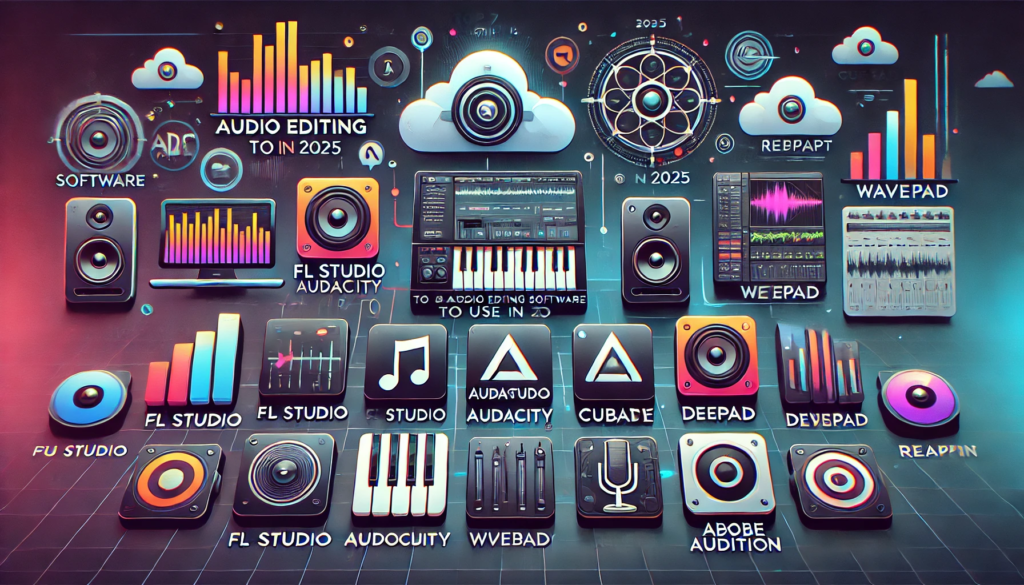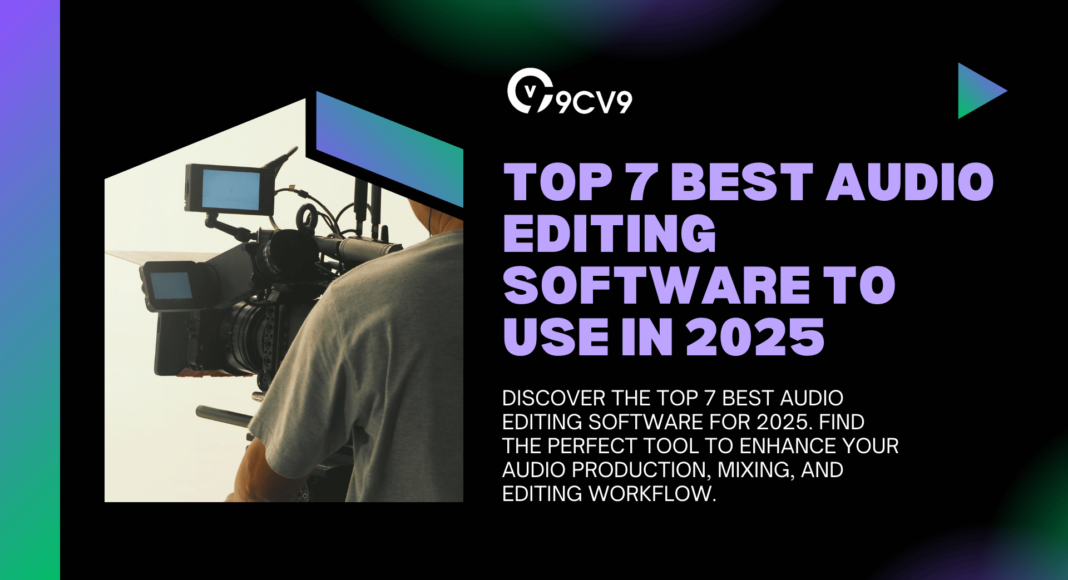Key Takeaways
- Discover the best audio editing software for 2025, offering advanced features like multi-track editing, sound effects, and seamless integrations for both beginners and professionals.
- From free tools like Audacity to professional-grade platforms like FL Studio, explore top-rated options tailored to enhance your audio production and editing capabilities.
- Choose the perfect audio editing software for your needs in 2025, with options that provide powerful customization, batch processing, and intuitive workflows for optimal sound creation.
In 2025, the demand for high-quality audio editing software is soaring as both professionals and amateurs alike seek efficient, user-friendly tools to enhance their audio projects.
Whether you’re a musician, podcaster, content creator, or audio engineer, having the right software can make all the difference in achieving the perfect sound.
The world of audio editing has evolved significantly over the years, with software now offering an array of powerful features that cater to diverse needs—ranging from simple audio tweaks to complex sound design and production.

As technology advances, so too do the capabilities of audio editing platforms, integrating artificial intelligence, advanced sound restoration tools, and collaborative features that make the editing process more intuitive and accessible.
2025 sees an influx of cutting-edge software that not only meets the technical demands of professionals but also offers seamless interfaces and unparalleled flexibility for beginners.
From user-friendly interfaces that simplify the learning curve to advanced functionalities that cater to the most intricate of tasks, these audio editing programs are designed to meet the diverse needs of today’s digital audio landscape.
In this blog, we explore the top 7 best audio editing software options for 2025.
These tools have been carefully selected based on their features, ease of use, compatibility with various platforms, and their ability to produce high-quality results.
Whether you’re looking to enhance the sound quality of your podcast, mix music tracks, or create engaging audio content for social media, the right software will not only elevate your projects but also streamline your workflow.
Keep reading as we delve into each tool’s strengths, unique features, and why they’re considered the best in the industry for 2025.
Before we venture further into this article, we would like to share who we are and what we do.
About 9cv9
9cv9 is a business tech startup based in Singapore and Asia, with a strong presence all over the world.
With over nine years of startup and business experience, and being highly involved in connecting with thousands of companies and startups, the 9cv9 team has listed some important learning points in this overview of the Top 7 Best Audio Editing Software to Use in 2025.
If your company needs recruitment and headhunting services to hire top-quality employees, you can use 9cv9 headhunting and recruitment services to hire top talents and candidates. Find out more here, or send over an email to [email protected].
Or just post 1 free job posting here at 9cv9 Hiring Portal in under 10 minutes.
Top 7 Best Audio Editing Software to Use in 2025
1. Adobe Audition

Adobe Audition stands as one of the premier audio editing platforms in 2025, renowned for its robust capabilities, industry-leading precision, and seamless integration with other Adobe tools. Positioned as a professional-grade digital audio workstation (DAW), Audition caters to a diverse range of users, including podcasters, musicians, sound designers, and video editors, making it an indispensable asset for audio creation, mixing, and restoration.
What sets Adobe Audition apart is its multifaceted approach to audio editing, offering users a comprehensive toolset that includes multitrack editing, waveform and spectral display, along with advanced features tailored for high-quality audio production. This software is engineered to elevate video production workflows, audio finishing, and sound design by providing crystal-clear, polished mixes that meet the highest standards of professional audio work.
In addition to its powerful editing functions, Adobe Audition excels in audio restoration and repair. The software includes sophisticated tools such as the Spectral Frequency Display, which allows users to visually identify and correct issues like background noise, pops, and clicks with pinpoint accuracy. The integration of adaptive noise reduction further enhances its utility, as it intelligently detects and eliminates unwanted sounds from recordings. This makes Audition an essential tool for video production, podcasting, and sound effects design, where audio clarity is paramount.
The software’s workflow is streamlined to enhance user experience, whether you’re working on a simple podcast episode or a complex sound design project. For instance, the Essential Sound panel simplifies the process of achieving professional-quality audio, even for those with minimal audio editing expertise. This makes it an ideal choice for beginners and experienced professionals alike. Users can quickly learn the ropes with step-by-step tutorials that cover everything from recording and mixing to exporting audio content. Furthermore, its ability to automatically remix tracks to fit specific durations allows for unparalleled flexibility in editing music for various media formats.
For those in the podcasting world, Adobe Audition provides specialized features that help users record, mix, and export audio content seamlessly. The software’s multitrack capabilities allow for simultaneous recording from multiple sources, providing a high degree of control over the final audio product. Additionally, Audition supports external plugins (VST, VST3, AU), offering further customization and expansion of its functionality.
Adobe Audition’s integration with other Adobe Creative Cloud apps, such as Adobe Premiere Pro, After Effects, and Adobe Stock, adds to its versatility. This synergy makes it easy to incorporate visual elements, animations, and stock footage, creating a unified and highly efficient production environment. Whether you’re adjusting sound for video editing or working on radio production, Audition’s customizable interface allows users to adapt the layout to their specific needs, whether for single-track editing, multitrack mixing, or surround-sound video production.
As an audio editing powerhouse, Adobe Audition continues to lead the industry, with consistent updates that enhance its performance and compatibility with the latest versions of macOS and Windows. The regular introduction of new features ensures that users always have access to cutting-edge tools to keep up with evolving industry standards.
For professionals who require precision, versatility, and reliability, Adobe Audition stands out as one of the top audio editing software solutions of 2025, delivering everything needed to produce high-quality audio content across a variety of media formats. With its comprehensive toolset, unmatched flexibility, and seamless integration with other Adobe applications, Audition is an essential software choice for those serious about taking their audio editing to the next level.
2. Audacity

Audacity has long been recognized as one of the best free audio editing software solutions, particularly for handling large and complex audio projects in 2025. Despite being a lightweight program, Audacity is equipped to manage long-duration recordings, such as audiobooks or multi-hour podcasts, without compromising performance. Its resilience is further demonstrated by the automatic crash recovery feature, which ensures that users won’t lose valuable progress in the event of an unexpected shutdown, making it an invaluable tool for professionals and hobbyists alike.
Designed with advanced users in mind, Audacity offers a robust set of features typically found in paid software, without the financial burden. This makes it an excellent choice for budget-conscious individuals or those just starting out but needing a tool with high-end capabilities for professional-grade projects. The software supports unlimited audio tracks, giving users the freedom to work with as many layers of audio as needed. Additionally, its suite of restoration tools, batch processing functionality, and spectral/spectrogram views provide the precision and flexibility required for high-quality audio editing, making it suitable for a wide range of applications, from detailed sound restoration to creative sound design.
One of Audacity’s standout features is its comprehensive set of audio effects, including reverb and distortion, which can be applied with ease to enhance or modify the sound of a recording. It also includes essential editing tools such as cut, copy, paste, and delete, all of which are fundamental to editing workflows. Audacity’s interface is clean and intuitive, resembling that of many professional Digital Audio Workstations (DAWs), which makes the transition easier for users familiar with other advanced software. Recent updates have even introduced additional musical features, such as a beats and measures grid and time-stretching capabilities, making Audacity a versatile tool for both audio editing and music production.
While Audacity’s free price point makes it particularly attractive to beginners, it should be noted that mastering the software requires a certain investment of time and effort. The program offers a steep learning curve for those unfamiliar with audio editing, but the vast array of tutorials and community resources available can assist in overcoming this challenge. For more experienced users, Audacity serves as an excellent platform for refining their craft, with its array of advanced features and customizable settings.
The software’s extensive list of features ensures that it meets the needs of professionals and advanced users, while its simplicity and affordability make it an ideal starting point for those looking to learn the ropes of audio editing. Some of Audacity’s notable functionalities include:
- Audio Capture & Recording: Capture and record multiple tracks simultaneously with ease.
- Audio Mixing & Editing: Includes advanced tools for mixing and editing audio, with support for various file formats.
- Batch Processing: Efficiently process large batches of audio files, saving time on repetitive tasks.
- Spectral/Spectrogram Views: Visualize and edit audio in a spectrum view for more precise editing and analysis.
- Configurable Workflow: Customizable interface to streamline your workflow based on your specific needs and preferences.
- Multi-format Support: Import and export a wide range of audio formats, ensuring compatibility with other programs and devices.
- Project Management Tools: Includes tools for managing projects, tracking progress, and organizing files, which is ideal for handling complex projects.
In summary, Audacity remains one of the best free audio editing software options in 2025, particularly for users looking for a powerful, versatile, and professional-grade tool on a budget. Its wide range of features, including advanced restoration tools, batch processing, and musical editing capabilities, make it a standout choice for anyone needing a reliable audio editor, whether they’re working on podcasts, audiobooks, music production, or other audio-related projects.
3. FL Studio

FL Studio is widely regarded as one of the premier music production software options in 2025, offering a comprehensive, all-in-one Digital Audio Workstation (DAW) that empowers musicians, producers, and audio engineers to create, mix, and master music at the highest professional standards. What sets FL Studio apart is its versatility and user-friendly interface, which combine to create an environment ideal for both seasoned professionals and aspiring music creators.
At the heart of FL Studio is its Playlist dashboard, a powerful tool that allows users to manage and sequence multiple track elements with ease. The drag-and-drop functionality enhances the workflow by enabling users to arrange and layer tracks effortlessly, helping them streamline the entire production process from start to finish. This intuitive interface ensures that users can focus on the creative aspects of music production rather than becoming bogged down by complicated controls or convoluted features.
A standout feature of FL Studio is its extensive collection of native instruments and effects that come bundled with the software. These tools provide musicians with a vast array of sound possibilities, from cutting-edge synths to high-quality audio effects. However, for those looking to expand their sound library even further, FL Studio offers an online store where users can purchase additional plugins, synths, and effects. These plugins, along with the ability to integrate a wide range of VST 1, 2, and 3 standards, make FL Studio a versatile and adaptable DAW that can accommodate almost any production style, from electronic and hip-hop to rock and classical.
The Piano Roll feature is another highlight of FL Studio, providing users with a powerful tool to sequence notes with precision. This functionality allows for complex musical compositions, even for those who may not have access to live instruments. By providing a user-friendly interface for editing and manipulating notes, the Piano Roll makes it easier than ever to create intricate melodies, harmonies, and rhythm patterns that form the backbone of any track.
For audio mixing and mastering, FL Studio boasts a wide range of professional-grade features. These include effects chains, side-chain control, plugin delay compensation, and more, all of which are designed to give users total control over their sound. The ability to fine-tune individual tracks and apply effects in a non-destructive manner ensures that the final mix sounds polished and cohesive. Additionally, FL Studio’s 1000+ presets and samples and loops provide users with a wealth of creative possibilities, enabling them to quickly experiment with different musical styles or build on existing ideas.
Whether you are a beginner looking to learn music production or a seasoned professional needing a powerful tool for complex projects, FL Studio offers an unparalleled range of features. It is particularly favored for its ability to seamlessly integrate a vast number of plugins, including VST effects, synths, and sound libraries, giving users access to virtually unlimited creative possibilities. Furthermore, its pattern-based sequencer and highly customizable interface ensure that every step of the production process, from composition to editing and mixing, can be handled with ease and precision.
In summary, FL Studio remains one of the top 7 best audio editing software to use in 2025 due to its extensive feature set, exceptional sound capabilities, and user-friendly interface. Its ability to handle everything from basic audio editing to advanced mixing and mastering, coupled with its robust plugin support, makes it a go-to DAW for music producers around the world. Whether you’re producing electronic beats, orchestrating cinematic scores, or recording live instruments, FL Studio offers the tools you need to create professional-quality music with ease and efficiency.
4. Cubase

Cubase stands out as one of the leading audio editing software options in 2025, offering a comprehensive suite of features that cater to both seasoned music professionals and aspiring creators. This music production software is designed to streamline the creative process by allowing users to modify audio files, produce original tracks, and optimize workflows for various projects, all within a unified and intuitive interface. Its advanced tools make it an ideal choice for businesses in the music industry and independent musicians alike, ensuring that every step of the production process is as efficient and effective as possible.
One of Cubase’s most powerful features is its quantize panel, which enables users to manage key aspects of their tracks, such as pitch, tempo, arrangement, and audio distribution. By using warp markers, musicians can precisely adjust the timing and structure of their audio, making it easier to sync multiple tracks and maintain consistent rhythm and pitch across the entire composition. This functionality ensures that even the most intricate arrangements can be edited with ease, offering a level of control that is essential for professional music production.
Another standout feature is Chord Pads, which provides composers with a flexible tool to enhance their music’s harmonic structure. This feature allows users to create and modify chords, jam with different chord patterns, and perform tracks using a MIDI controller. Additionally, the Chord Pads enable composers to refine their work by adjusting tension, voicings, and other musical elements, helping them to achieve the exact sound and mood they desire. With this capability, Cubase offers unparalleled flexibility in managing musical composition and performance, which is crucial for musicians seeking to create original, high-quality music.
Cubase also excels in its ability to manage and organize complex projects. The MediaBay tool allows users to quickly search for, organize, and access audio files, tracks, and other content, making it easier to keep everything in one place. With its project browser, users can efficiently view and modify multiple projects, events, and tracks, which is especially useful when working with large, multifaceted projects. Moreover, Cubase’s track import functionalitystreamlines the process of syncing data between different projects, enabling users to import tracks, folders, groups, FX, and more from other compositions. This integration capability allows for seamless collaboration and workflow continuity, making Cubase an invaluable tool for those working on diverse or ongoing music projects.
In addition to its robust core features, Cubase offers a range of essential tools, including spectral comparison, scale assistant, batch exporter, notepad, and latency monitoring. These features enhance the overall efficiency and effectiveness of the music production process, ensuring that musicians can maintain high standards of sound quality while also streamlining their workflow. The platform’s colorized mixer channels add another layer of visual organization, helping users quickly navigate and adjust their projects without getting overwhelmed by complex menus or layouts.
Furthermore, Cubase supports personalized workspaces, allowing users to customize the software’s layout according to their specific needs. Whether for adjusting window sizes, positions, or dialogs, this feature enables musicians to design a workspace that best suits their creative process. This flexibility is especially valuable when managing multiple projects simultaneously, as it ensures that all the tools and functions are easily accessible.
Overall, Cubase’s combination of powerful audio editing tools, comprehensive workflow management features, and customizable workspace options make it a top-tier choice for music professionals and businesses alike. Its ability to handle everything from complex audio manipulation to project organization and collaboration positions Cubase as one of the top 7 best audio editing software for 2025. Whether you are producing intricate compositions, editing audio files, or designing unique musical arrangements, Cubase offers the versatility and precision required to achieve the highest standard of audio production.
5. WavePad

WavePad is a comprehensive and versatile audio editing software that has garnered attention as one of the best audio editing tools available in 2025. Designed to provide users with a robust suite of features, it is compatible with a wide range of devices, including Windows, Mac, iOS, and Android platforms. This cross-platform flexibility allows musicians, producers, and content creators to seamlessly edit and modify audio files no matter the device they are using, making it a highly accessible tool for both amateurs and professionals.
One of WavePad’s standout qualities is its ability to handle a wide array of audio formats, including M4A, AAC, MP3, WAV, FLAC, OGG, and more. This extensive support for multiple file types ensures that users can work with almost any audio file, regardless of its origin or format. This makes WavePad an essential tool for anyone in the audio production field, as it ensures versatility and compatibility with a broad spectrum of audio content.
Key Features that Make WavePad a Top Choice for 2025
WavePad excels in its comprehensive suite of audio editing tools that empower users to manipulate audio with precision. Whether you need to cut, copy, paste, or delete sections of your audio files, the software offers an intuitive and straightforward interface to perform these actions quickly. In addition to these basic editing functions, WavePad provides more advanced capabilities such as echo, noise reduction, reverb, and even the ability to reverse audio for creative effects. The software also boasts batch processing, which allows users to apply effects to multiple files simultaneously, thus saving time and streamlining workflows, especially for those working with large volumes of audio content.
For those working on music production, WavePad offers tools such as amplification, normalization, equalization, and auto-trimming, which enhance the overall sound quality and ensure consistency throughout projects. The spectral analysis feature is particularly beneficial for detailed audio editing, as it provides users with a visual representation of their audio files, making it easier to identify and address any issues. In addition, the software includes pitch shifting, which gives users the ability to adjust the tone and pitch of their audio, making it an invaluable tool for music producers looking to fine-tune their tracks.
One of the most appealing aspects of WavePad is its sound effects library, which includes a vast collection of royalty-free sound effects. This is a particularly valuable resource for content creators, podcasters, and filmmakers, as it provides access to high-quality effects that can be used to enhance their projects without the need for additional licensing fees. Additionally, WavePad allows users to create ringtones directly from their audio files, providing yet another layer of versatility for musicians and everyday users alike.
The software also offers features tailored for beginners. With its easy-to-use interface, WavePad makes it simple for those new to audio editing to experiment with a variety of effects, including amplify, normalize, envelope, echo, and reverse, to name a few. These effects are quick to apply and require no technical expertise, making it an excellent choice for those looking to get started in audio editing without feeling overwhelmed by complex tools and features.
Additional Functionalities and Integration
Another notable aspect of WavePad is its support for audio restoration, which allows users to remove unwanted noises, such as clicks, pops, or hums, from their audio files. This is especially useful for those working with older recordings or audio that has been captured in less-than-ideal conditions. Additionally, WavePad integrates with DirectXand VST DLL plugins, enabling users to expand their creative possibilities by incorporating third-party effects and plugins into their projects. The integration with MixPad multitrack recording software further enhances its functionality, allowing for more complex audio production workflows that involve multiple tracks and layers.
WavePad for Advanced Users and Hobbyists Alike
While WavePad offers a wealth of features for beginners, it is also powerful enough for advanced users. Its advanced editing tools, combined with a high level of customization and the ability to handle complex audio projects, make it a great choice for both professional audio engineers and casual users. Whether you are looking to produce music, edit podcasts, or create sound effects, WavePad’s combination of user-friendly tools and advanced features allows it to cater to a diverse range of audio editing needs.
Why WavePad is One of the Top Audio Editing Software in 2025
In summary, WavePad distinguishes itself as one of the top 7 best audio editing software in 2025 by offering a robust, all-encompassing toolkit that caters to a wide variety of users. Its compatibility with numerous audio formats, array of editing features, sound effects library, and integration options make it a versatile and powerful choice for both hobbyists and professionals. Its user-friendly interface, combined with advanced functionality, allows WavePad to meet the needs of any audio editing project, making it a top contender in the competitive world of audio production software. Whether you are a beginner exploring the world of audio editing or an experienced producer working on complex projects, WavePad offers the tools and flexibility required to bring your creative vision to life.
6. AVS Audio Editor

AVS Audio Editor is a robust and versatile audio editing tool that has earned its place as one of the best audio editing software available in 2025. With its user-friendly interface and powerful features, it is a highly recommended choice for both beginners and seasoned audio professionals. This software equips users with a wide range of editing tools, allowing them to cut, trim, join, split, and delete parts of audio files seamlessly. Whether you’re working with music tracks, podcasts, or sound effects, AVS Audio Editor provides the necessary capabilities to manipulate audio content with precision.
Comprehensive Audio Editing Tools and Capabilities
One of the standout features of AVS Audio Editor is its comprehensive suite of editing tools that enable users to effortlessly modify audio files. Users can easily cut, trim, join, and split audio clips, as well as delete or extract specific sections with ease. The software also allows for the creation of dynamic mixes by combining different audio tracks, making it an excellent tool for both simple editing and more complex projects. With the ability to handle various audio file formats, AVS Audio Editor offers broad compatibility, allowing users to work with a diverse range of audio content.
In addition to its basic editing functions, AVS Audio Editor supports recording audio from multiple inputs, including vinyl records, microphones, and other audio sources connected via a sound card. This makes it an ideal tool for capturing live audio, digitizing old vinyl records, or recording custom voiceovers. This feature is especially valuable for users who wish to preserve and enhance their analog audio collections or create high-quality recordings for podcasts, music, or other projects.
Enhancing Audio Quality with Advanced Features
A key aspect of AVS Audio Editor is its ability to improve audio quality through a range of advanced features and filters. The software includes specialized noise reduction tools that can eliminate unwanted sounds such as hissing, crackling, and roaring. This is particularly useful for users working with older recordings, low-quality recordings, or audio that has been compromised by background noise. By applying these filters, users can restore and enhance the overall clarity of their audio files, ensuring a more professional and polished final product.
The software also includes a variety of sound effects and filters that can be applied to audio tracks. With over 50 different sound effects, users can experiment and manipulate their audio in creative ways. These effects allow for the enhancement of the mood, tone, and atmosphere of a track, whether it’s adding an echo effect, altering pitch, or applying special filters to create a unique sound. This extensive collection of effects makes AVS Audio Editor an incredibly versatile tool for audio production, giving users the flexibility to fine-tune their audio to meet their creative vision.
Simplified Audio Management and Auto Correction Features
For those managing large audio collections, AVS Audio Editor offers efficient audio management features that allow for easy organization and auto-correction of tracks. This makes it easy for users to keep track of their projects and maintain a well-organized library of audio files. Additionally, the software allows users to edit audio directly from video files, making it an excellent choice for video producers or content creators who need to sync audio with their visuals.
Why AVS Audio Editor is a Top Choice in 2025
In 2025, AVS Audio Editor remains one of the best audio editing software options for users seeking a comprehensive, yet accessible tool for audio editing and recording. Its combination of intuitive editing features, advanced noise reduction and sound enhancement capabilities, and vast collection of effects makes it an indispensable resource for anyone involved in audio production. Whether you’re a beginner looking for an easy-to-use platform to edit your first podcast or a professional audio engineer refining complex tracks, AVS Audio Editor offers the flexibility and power required to complete your projects with precision and quality.
This software’s support for recording from various audio sources, coupled with its high-quality editing tools and extensive library of effects, positions it as a top contender in the competitive field of audio editing. Whether used for music production, podcasting, or sound design, AVS Audio Editor delivers the tools and features that professionals and hobbyists alike need to achieve their creative goals.
7. Descript

Descript has emerged as one of the most innovative and versatile tools in the audio editing landscape. Recognized as one of the top 7 best audio editing software in 2025, Descript offers a seamless and highly efficient multimedia editing experience that is designed to simplify the traditionally complex process of audio and video editing. What sets Descript apart is its unique approach to editing, combining powerful features with a user-friendly interface that makes editing as intuitive as working with a word document.
An All-in-One Audio and Video Editing Platform
Descript stands out as an all-in-one multimedia editing solution, catering to both audio and video content creators. Whether you are a podcaster, video creator, or content producer, Descript streamlines the editing process and allows you to work seamlessly across various forms of media. The platform allows users to easily upload media files or record audio and video directly within the app, eliminating the need for multiple separate software applications for different tasks.
One of the key features of Descript is its automatic transcription. Once you upload a media file or start recording, Descript instantly transcribes your audio or video into text. This revolutionary feature allows users to edit their audio or video content directly through text-based edits, providing a quick and intuitive way to fine-tune their projects. By simply tweaking the text, users can modify the content of their media clips, eliminating the traditional need for complex timeline-based editing. This text-to-audio editing capability significantly reduces the time and effort typically spent on manual editing, making Descript an ideal tool for professionals working under tight deadlines.
Effortless Editing and Streamlined Workflow
For many users, audio editing involves tedious tasks such as removing filler words, silences, or background noise. Descript simplifies these tasks with just a single click. Users can easily edit out filler words like “um,” “uh,” and “you know,” as well as remove unnecessary pauses or silences, ensuring that their audio files remain polished and professional. This feature is especially useful for podcasters or content creators who need to streamline their recordings and maintain listener engagement without the hassle of manually searching for these common distractions.
Descript also offers a screen recording feature, making it a comprehensive tool for presentations, tutorials, and video messages. Whether you’re recording a software demo, creating an instructional video, or delivering a business presentation, Descript allows you to record both your screen and webcam simultaneously. After recording, users can quickly edit and refine their content by cutting out mistakes, trimming unnecessary footage, and enhancing audio quality—all before sharing or publishing.
Collaboration and Export Capabilities
Another standout feature of Descript is its collaboration tools, which are essential for teams working on multimedia projects. Descript makes it easy for multiple users to collaborate on a single project, whether they’re adding notes, making edits, or reviewing content. This is especially beneficial for video producers, marketing teams, and media agencies who require real-time input from various stakeholders.
Descript’s export functionality ensures that users can seamlessly integrate their projects with other professional applications. Once editing is complete, projects can be exported to other pro apps for further refinement, allowing users to continue working with specialized tools if necessary.
Why Descript is Among the Top Audio Editing Software in 2025
In 2025, Descript remains one of the best choices for audio and video editing, offering a cutting-edge, intuitive interface and powerful transcription and editing capabilities. The software’s ability to transcribe audio into text and edit media directly through text-based modifications makes it an invaluable tool for anyone involved in multimedia production. Descript caters to a wide range of use cases, from podcasting to corporate presentations, and its ability to simplify complex editing tasks is unmatched.
The platform’s time-saving features—such as automatic filler word removal, seamless screen recording, and collaborative tools—further enhance its appeal. Whether you’re working individually or as part of a team, Descript enables you to streamline your workflow and produce high-quality audio and video content faster than ever before. Given its flexibility, user-friendly interface, and powerful capabilities, Descript is undeniably one of the top audio editing software solutions for 2025.
Conclusion
In the ever-evolving world of audio editing, selecting the right software is critical for producing high-quality, professional sound that meets the demands of today’s diverse media landscape. Whether you’re a music producer, podcaster, videographer, or content creator, having access to powerful, intuitive, and versatile audio editing software is essential to stay ahead in the competitive market. As we move into 2025, the top 7 best audio editing softwaresolutions offer a range of features and tools designed to streamline the editing process, enhance creativity, and boost productivity.
From industry-standard programs like FL Studio and Cubase, to emerging platforms such as Descript, each software solution brings unique strengths to the table, making it important for users to carefully consider their specific needs and preferences before making a choice. These tools not only help you perfect the sound quality of your projects but also provide powerful features such as advanced mixing, editing, and recording capabilities, ensuring your audio content is of the highest standard.
FL Studio: A Versatile Powerhouse for Music Producers
FL Studio continues to dominate the audio editing landscape for 2025, offering musicians and producers an all-in-one environment for crafting intricate music compositions. With an extensive library of plugins, synths, and effects, FL Studio gives users the freedom to create, mix, and master audio seamlessly. Its Piano Roll and drag-and-drop capabilities, combined with VST plugin support, allow for maximum flexibility, making it an ideal choice for those who need professional-grade tools to bring their musical ideas to life.
Cubase: A Comprehensive Solution for Professional Composers
For musicians and composers seeking a more refined and customizable approach, Cubase remains a top contender. With features like chord pads, warp markers, and MIDI integration, it allows users to take control of every element of their audio, from composition to final mix. Cubase’s ability to synchronize and import tracks from other projects, coupled with its robust project browser, makes it an excellent choice for professionals who require precision and efficiency.
WavePad: The Ultimate Tool for Beginners and Casual Editors
WavePad is a highly accessible and intuitive option for beginners and hobbyists looking to explore the world of audio editing. Whether you’re working on podcast editing, music mixing, or basic sound design, WavePad’s comprehensive suite of effects, including normalization, equalization, and reverb, ensures you can create polished audio with ease. Its support for multiple file formats and simple batch processing tools makes it perfect for users who need to quickly edit and enhance their audio files.
AVS Audio Editor: Versatility at Its Best
For users in need of a versatile and affordable audio editing software, AVS Audio Editor delivers a wide range of features suited for both beginners and more advanced users. Its ability to handle multiple tasks—from audio recordingand editing to applying over 50 sound effects—makes it a standout choice. AVS Audio Editor’s comprehensive toolkit, including noise reduction and audio restoration, is ideal for anyone seeking to enhance their audio quality and create professional-grade projects.
Descript: Revolutionizing Audio and Video Editing for 2025
Descript has revolutionized the audio and video editing process, offering a streamlined, text-based approach to editing that saves time and increases efficiency. Its automatic transcription, coupled with easy-to-use editing features like filler word removal and screen recording, makes it an essential tool for content creators. Descript’s powerful collaboration features also allow teams to work together seamlessly, ensuring the editing process is smooth and organized, no matter the project’s scale.
Why These Tools Stand Out in 2025
The top 7 best audio editing software for 2025 are designed with the goal of enhancing both workflow efficiency and creative output. Whether you are looking for a complete DAW like FL Studio for music production, a highly customizable platform like Cubase for in-depth composition, or a beginner-friendly solution like WavePad for basic editing, there is a tool that fits every need and skill level.
These software solutions all provide a combination of advanced features and user-friendly interfaces, ensuring that both novice and professional users can achieve their desired results. Additionally, their ability to integrate seamlessly with other tools and plugins makes them highly adaptable and future-proof, ensuring that users are equipped to handle the demands of evolving audio production technologies.
Key Considerations When Choosing Audio Editing Software
When choosing the right audio editing software for your projects in 2025, it’s crucial to consider factors such as your specific needs, budget, workflow preferences, and the type of projects you’ll be working on. For instance, if you’re focused on music production and need robust mixing and mastering capabilities, FL Studio or Cubase might be the best fit. If you’re working with spoken content or video editing, tools like Descript could offer the perfect balance of ease-of-use and powerful editing features.
Ultimately, the software you choose should align with your personal or business goals, enabling you to achieve your desired audio quality without unnecessary complications. The best audio editing software for 2025 offers not only a powerful set of tools but also the flexibility to grow with your evolving needs as a creator, ensuring you remain at the cutting edge of audio production.
In Conclusion
As the world of audio editing continues to evolve, these top 7 best audio editing software solutions for 2025 offer the perfect mix of versatility, functionality, and ease of use. Whether you’re a professional producer, a content creator, or an aspiring musician, there’s an option that meets your needs. By carefully evaluating the features of each software and considering your specific project requirements, you can confidently choose the right tool to elevate your audio editing to new heights. With the right software in hand, you’ll be equipped to create high-quality audio content that resonates with your audience and sets you apart from the competition.
If you find this article useful, why not share it with your hiring manager and C-level suite friends and also leave a nice comment below?
We, at the 9cv9 Research Team, strive to bring the latest and most meaningful data, guides, and statistics to your doorstep.
To get access to top-quality guides, click over to 9cv9 Blog.
People Also Ask
What is the best audio editing software to use in 2025?
The best audio editing software in 2025 varies depending on your needs, but FL Studio, Audacity, and Cubase are widely regarded as top choices for both beginners and professionals.
Which audio editing software is free in 2025?
Audacity is a leading free audio editing tool in 2025, offering a robust set of features like multi-track editing, effects, and audio restoration tools without any cost.
Is FL Studio good for audio editing?
Yes, FL Studio is excellent for audio editing, particularly for music production. It offers advanced features like plugin support, piano roll sequencing, and a wide variety of effects for professional-level editing.
What features should I look for in audio editing software?
Look for features like multi-track editing, built-in effects, noise reduction, ease of use, compatibility with different formats, and integration with plugins to ensure flexibility and quality.
Is Audacity suitable for beginners?
Yes, Audacity is beginner-friendly due to its intuitive interface, but it offers enough advanced features for users who want to progress and take on professional audio editing projects.
Can you use FL Studio for podcast editing?
Yes, FL Studio can be used for podcast editing. It provides the necessary tools for editing audio, adjusting levels, and adding effects, making it suitable for podcast production.
What is Cubase best used for?
Cubase is ideal for music production, sound design, and audio mixing. It offers features like chord pads, MIDI support, and audio editing tools, making it suitable for both beginners and advanced users.
Is WavePad a good choice for beginners?
Yes, WavePad is an excellent choice for beginners. It provides a straightforward interface and offers essential editing tools such as cut, copy, paste, and a wide range of audio effects.
Can I use WavePad for professional audio editing?
While WavePad is beginner-friendly, it also has enough advanced features, like noise reduction, equalization, and batch processing, for semi-professional audio editing tasks.
What makes Audacity popular in 2025?
Audacity remains popular in 2025 because it’s free, open-source, and packed with powerful features like multi-track editing, effects, and compatibility with numerous file formats, making it perfect for both beginners and professionals.
Does FL Studio offer a free version?
No, FL Studio does not offer a free version, but it does offer a demo version with limited functionality. The full version includes advanced features and tools for audio and music production.
What are the best plugins for Cubase in 2025?
Some of the best plugins for Cubase in 2025 include VST instruments like Omnisphere, Serum, and Native Instruments’ Komplete suite, which offer high-quality sound design options for producers and musicians.
How much does WavePad cost?
WavePad offers both a free version with limited features and a paid version starting at approximately $60 for a single license, which unlocks additional features like batch processing and advanced effects.
Can I record audio directly in Audacity?
Yes, Audacity allows you to record audio directly into the software using a microphone or other input devices, making it versatile for both live recordings and editing existing files.
Is FL Studio suitable for beginners?
Yes, FL Studio is suitable for beginners, with its easy-to-use interface and a range of tutorials. However, its advanced features may require a learning curve for complete beginners to music production.
What are the system requirements for Cubase?
Cubase requires a 64-bit processor, at least 4GB RAM (8GB recommended), and a Windows 10 or macOS system. The software is resource-intensive, so a powerful system is recommended for smooth performance.
Is WavePad available for mobile devices?
Yes, WavePad is available for both iOS and Android devices, allowing you to edit audio files on the go with its mobile-friendly interface.
How does FL Studio compare to other DAWs?
FL Studio stands out for its powerful piano roll, user-friendly interface, and flexibility in music production. While DAWs like Cubase and Ableton Live are also strong contenders, FL Studio excels in its ease of use for electronic music creation.
Can you export FL Studio projects to other software?
Yes, FL Studio allows you to export your projects to other DAWs and formats, making it versatile for collaboration with others using different software tools.
What types of audio formats does Cubase support?
Cubase supports a wide range of audio formats, including WAV, MP3, AIFF, and FLAC, allowing you to import and export your projects in various formats to suit your needs.
Is Cubase suitable for video audio editing?
Yes, Cubase can be used for video audio editing, as it provides features for synchronizing audio with video, making it suitable for multimedia projects.
What are the best features of Audacity?
Audacity’s best features include its multi-track editing, plugin support, noise removal tools, and the ability to handle a variety of audio file formats, making it a versatile choice for audio editing in 2025.
Can WavePad handle large audio projects?
Yes, WavePad can handle large audio projects, but for very complex tasks, you may want to explore other professional software that offers more processing power for large-scale productions.
Is FL Studio good for live performances?
Yes, FL Studio is excellent for live performances due to its performance mode, which allows for triggering clips, loops, and samples in real-time, making it ideal for DJs and electronic artists.
Does Audacity support VST plugins?
Yes, Audacity supports VST plugins, allowing users to expand its functionality with additional effects and virtual instruments for more advanced audio editing and production.
How does Cubase handle MIDI?
Cubase offers advanced MIDI features, such as MIDI editing, automation, and support for external MIDI instruments, making it an excellent choice for MIDI-based music production.
What are the main advantages of using WavePad for audio editing?
WavePad’s main advantages include its user-friendly interface, powerful audio effects, batch processing, and support for multiple file formats, making it suitable for both beginners and advanced users.
Can I use FL Studio for podcast production?
Yes, FL Studio can be used for podcast production, providing tools for editing, mixing, and adding effects to your podcast audio for a polished final product.
What makes Cubase a top choice for music producers?
Cubase is a top choice for music producers due to its professional-grade audio editing features, MIDI capabilities, comprehensive plugin support, and versatile workflow options.
Does WavePad have noise reduction features?
Yes, WavePad includes noise reduction tools that allow you to remove background noise, hiss, or hum from your audio recordings, ensuring a cleaner, more professional sound.
What type of audio editing tasks can I perform with FL Studio?
FL Studio allows you to perform tasks like recording, mixing, mastering, and adding effects to audio tracks, making it a comprehensive audio editing and music production tool.
Is Cubase a one-time purchase or subscription-based?
Cubase offers both one-time purchase options and subscription-based pricing, giving users flexibility depending on their needs and budget.
Does Descript offer video editing features?
Yes, Descript offers both audio and video editing capabilities, making it a powerful all-in-one tool for podcasters, content creators, and multimedia producers.































![Writing A Good CV [6 Tips To Improve Your CV] 6 Tips To Improve Your CV](https://blog.9cv9.com/wp-content/uploads/2020/06/2020-06-02-2-100x70.png)


